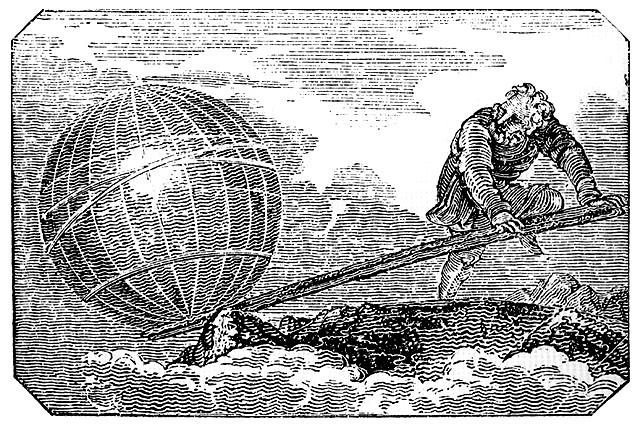
Rotational Equilibrium
It is easier to open a heavy door when you know where the hinges are. Then
you know to apply your force at the opposite end of the door. You also know to
push perpendicular to the door's surface. What you are doing here is (for the
given force) maximixing your torque.
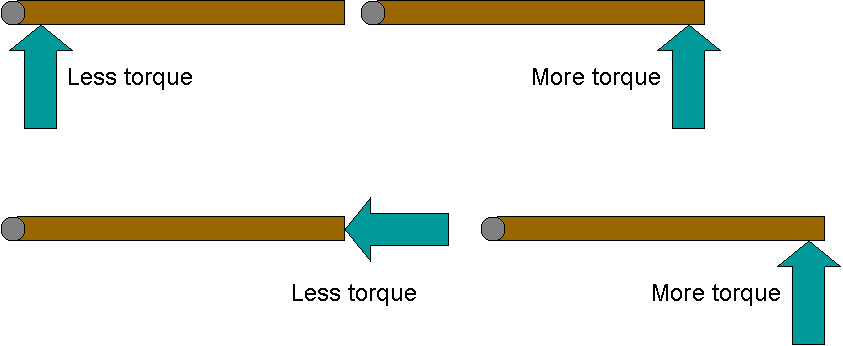
The important factors in determining torque are
- the magnitude of the force applied
- the distance between the axis of rotation and the position where the force
is applied
- the angle between the force and the line connecting the axis to the
application point
Just as the net force must be zero in order for
there to be no acceleration, the net torque must be zero in order for there to
be no angular acceleration (rotation). Thus no net torque is another condition
for static equilibrium.
Part 1
Set up a lever-type system. Recall the following definitions regarding levers.
Fulcrum: the point about which a lever rotates – if the lever is moving this is the
point that remains stationary
Lever arm: the (perpendicular) distance between the point where a force (a.k.a. an effort)
acts on a lever and the fulcrum
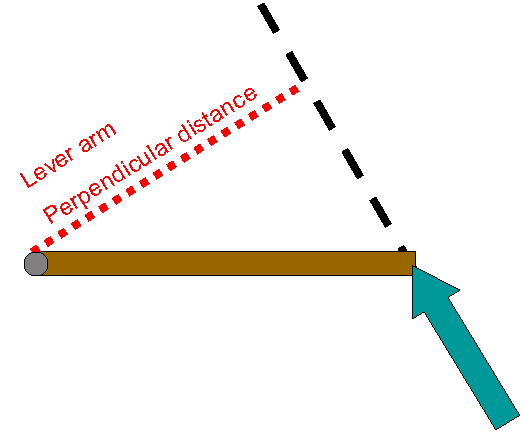
- Obtain the mass of a thick meter stick.
- Obtain the mass of a bracket used to suspend a hanger from the meter
stick.
- Attach one bracket near the center of the meter stick and place it on the
stand as shown below.
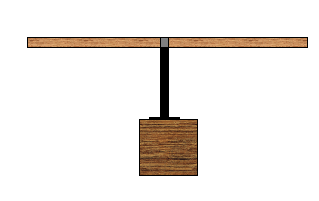
- Adjust the position of the bracket until the meterstick is balanced
as shown above.
- Record the position (relative to the end of the meterstick) of the center
of the bracket.
- This position is the center of mass of the meterstick,
xCM,stick. (It is also its center of gravity since the
gravitational field is uniform). The upward force coming from the stand must
pass through the center of mass for the stick to be balanced. Is it where you
expect?
| Mstick ( ) |
x CM,stick ( ) |
| |
|
- Add another bracket and suspend a hanger from it as shown below.
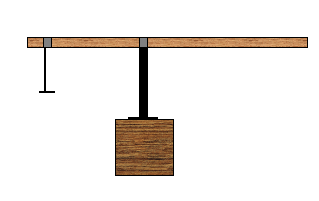
- Adjust the position of the bracket that sits on the stand until the
meterstick is balanced as shown above.
- Record the positions (from the end of the meterstick) of the pivot point
and the hanger.
Pivot
Position
( ) |
Hanger
Position
( ) |
| |
|
| |
|
| |
|
- From the information above calculate the lever arms R (the perpendicular
distance from the axis of rotation to the line of action of the force)
associated with the stick's center of mass RCM and the hanger Rhang. Also
record the masses.
RCM,stick
( ) |
Mstick
( ) |
Rhang
( ) |
Mhang
( ) |
Clockwise
Torques
( ) |
Counter-
clockwise
Torques
( ) |
Total
Torque
( ) |
| |
|
|
|
|
|
|
| |
|
|
|
|
|
|
| |
|
|
|
|
|
|
- Calculate the clockwise torque(s) about the axis of rotation – the torques that
would if unbalanced make the stick rotate in a clockwise direction.
- Calculate the counterclockwise torque(s).
- Determine the net torque. (Note that clockwise and couterclockwise torques are
considered to be in opposite directions.)
- Repeat the measurements and calculations twice more, changing the mass
hanging at least once and the hanger position xhang,1 at least
once.
- Next, add a second hanger to the system, balance it, and record the positions,
masses and lever arms.
Pivot
Position
( ) |
Hanger 1
Position
( ) |
Hanger 2
Position
( ) |
| |
|
|
| |
|
|
| |
|
|
RCM,stick
( ) |
Mstick
( ) |
Rhang,1
( ) |
Mhang,1
( ) |
Rhang,2
( ) |
Mhang,2
( ) |
Clockwise
Torques
( ) |
Counter-
clockwise
Torques
( ) |
Total
Torque
( ) |
| |
|
|
|
|
|
|
|
|
| |
|
|
|
|
|
|
|
|
| |
|
|
|
|
|
|
|
|
- Repeat the measurements twice more. At least one time both hanger masses
must be on the same side of the stand.
We have been treating all of the mass of the meterstick as acting at one
point: its center of mass. From this point of view the weight of the stick leads
to just one torque which might be clockwise or counter-clockwise. But part of the
stick is to the right of the axis and should cause a clockwise torque, while the
rest of the stick is to the left and should cause a counter-clockwise torque.
Let us re-analyze the data from the part with one hanger from this new point of
view.
- Assume the density of the meterstick is uniform and calculate the mass and
center of mass of the right part of the stick (to the right of the axis).
- Similarly calculate the mass and center of mass of the left part of the
stick.
Rstick,right
( ) |
Mstick,right
( ) |
Rstick,left
( ) |
Mstick,left
( ) |
Rhang
( ) |
Mhang
( ) |
Clockwise
Torques
( ) |
Counter-
clockwise
Torques
( ) |
Total
Torque ( ) |
| |
|
|
|
|
|
|
|
|
| |
|
|
|
|
|
|
|
|
| |
|
|
|
|
|
|
|
|
- Calculate the clockwise, counter-clockwise and net torques.
Part 2: The boom
-
Measure the mass of a boom (half a meterstick).
-
Attach the boom to a ringstand with the bracket provided.
-
Hang a mass from the other end of the meter stick from the other bracket
provided.
- Clamp a small pole to the ringstand and attach one end of a force sensor
to it.
- Then tie a string from the other end of the spring balance to the top of
the bracket from which the mass is hanging. The string should be taut.
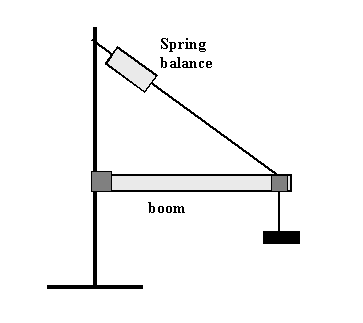
- Measure the tension using the spring balance.
- Measure the anngle between the string and the boom.
| Rboom ( ) |
Mboom ( ) |
Rhang ( ) |
Mhang ( ) |
Tension
( ) |
RTension
( ) |
Angle |
| |
|
|
|
|
|
|
| |
|
|
|
|
|
|
-
Change the mass hanging from the boom and repeat the measurements and
calculations.
- Calculate the clockwise, counter-clockwise and net torque about the pivot
point.
Clockwise
Torque ( ) |
Counter-
clockwise
Torque ( ) |
Net
Torque ( ) |
| |
|
|
| |
|
|
- Add a second mass between the first mass and the pivot point and make all
of the various measurements.
Rboom
( ) |
Mboom
( ) |
Rhang,1
( ) |
Mhang,1
( ) |
Rhang,2
( ) |
Mhang,2
( ) |
Tension
( ) |
RTension
( ) |
Angle |
| |
|
|
|
|
|
|
|
|
- Calculate the cloclwise, counter-clockwise and net torques.
Clockwise
Torque ( ) |
Counter-
clockwise
Torque ( ) |
Net
Torque ( ) |
| |
|
|
- In addition calculate the force (both components) exerted on the boom at
the pin (pivot point).
Part 3: The ladder calculation
Include as part of your lab, the calculations outlined in
torques.doc.


 PYL 105
PYL 105






 PYL 105
PYL 105










